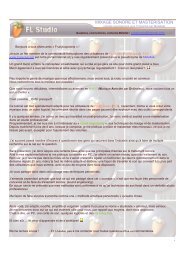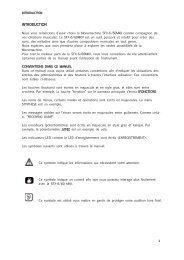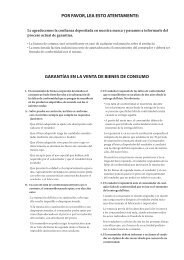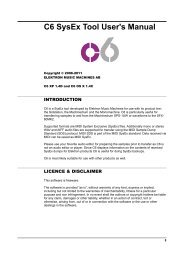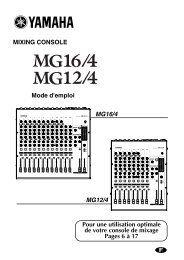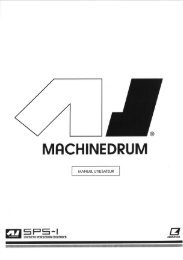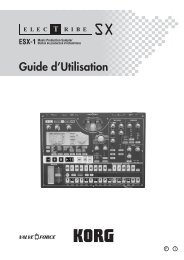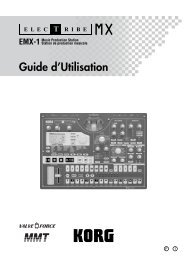Access Virus User Manual - SoundProgramming.Net
Access Virus User Manual - SoundProgramming.Net
Access Virus User Manual - SoundProgramming.Net
Create successful ePaper yourself
Turn your PDF publications into a flip-book with our unique Google optimized e-Paper software.
50 CHAPTER 4<br />
Introduction<br />
THE CHORUS/FLANGER<br />
EFFECT<br />
Another function that delivers<br />
great effects based on pitch fluctuation<br />
is the so-called chorus effect.<br />
Chorus actually consists of a brief<br />
delay (generally up to approx. 50<br />
ms) which is varied periodically. By<br />
modulating the delay, the delayed<br />
signal is slightly detuned to the<br />
input signal (the so-called Doppler<br />
effect). This inconsistency in pitch<br />
between the original and effects<br />
signal is the source of the chorus<br />
effect. Feedback in the delay line<br />
enhances this effect. The left signal<br />
side is automatically modulated<br />
in a different manner than<br />
the right, so a chorus effect is great<br />
for converting mono signals into<br />
stereo signals.<br />
If the delay is less than approx. 10<br />
milliseconds, than the effect is<br />
called flanging or a flanger effect<br />
rather than chorus. In this case<br />
feedback is even more significant<br />
because it generates resonances<br />
that can be modulated and is thus<br />
yet another source of radical sound<br />
effects. If you determine high feedback<br />
values, you can clearly hear<br />
how the two sides of the signal are<br />
modulated differently - in reverse<br />
phase - by the LFO.<br />
Locate the parameter group CHO-<br />
RUS in the EFFECTS menu.<br />
01111111111111111112<br />
1 CHORUS<br />
Dir/Eff<br />
OFF≤<br />
61111111111111111154<br />
CHORUS DIR/EFF determines the<br />
balance between the original signal<br />
and the processed signal. The<br />
parameters RATE and SHAPE control<br />
another LFO that was installed<br />
specifically for the chorus LFO.<br />
DELAY is used to set the delay time,<br />
DEPTH determines the modulation<br />
intensity, and FEEDBACK controls<br />
the feedback level. When you want<br />
to generate a flanger effect, the<br />
FEEDBACK parameter’s negative<br />
control range lets you dial in softer<br />
characteristics for the flanger.<br />
Please keep in mind that the Chorus<br />
section in the <strong>Virus</strong> is fully stereophonic:<br />
Stereo positions as well<br />
as panorama modulations and stereo<br />
spread values that you have<br />
dialed in elsewhere remain intact<br />
in the effects signal.



